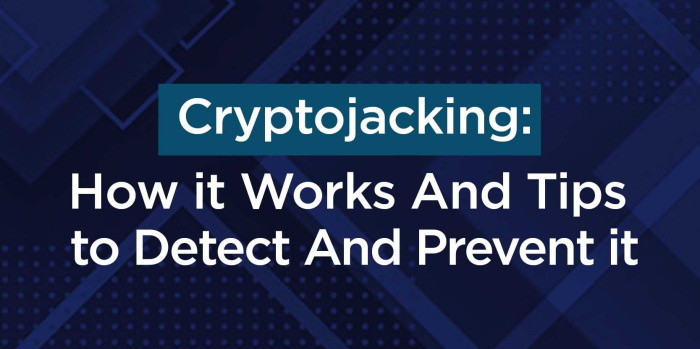
Cryptojacking: How it Works And Tips to Detect And Prevent it
As the world walks down the road of digitization at the speed of light, new forces need to be kept at bay, especially those that compromise your safety and security. In particular, the web is a playground for hackers, who have been causing malicious bugs, also known as viruses and malware, to latch onto computers since the early days of the internet. Hacks come in all shapes and forms, from $30 billion money laundering schemes to using automation for guessing the usernames and passwords of virtual game accounts.
While most hacks are easily noticeable due to their effects on your computer, some of the most notorious hacks that occurred in the metaverse were silent operatives that took months to discover. In 2018, cryptojacking became a worldwide phenomenon. It’s a hacking method favored by crypto miners, and despite being around since the early days of Bitcoin (a coin that has been hailed as a failed currency), it often carries its fangs during the peak of bullish markets—including now.
What Is Cryptojacking and How Does it Work?
Cryptojacking is the act of using a victim’s computer to mine for cryptocurrency without their knowledge. Previously, cryptojackers would infect devices with malware and then run simulations on those machines to make money. But as it becomes harder for hackers to find vulnerabilities and are at risk of being caught by authorities on the lookout for these types of threats, they’ve instead resorted to hacking publicly accessible computers that might be running outdated antivirus software or have weak passwords, often leading hackers into ordinary people’s homes and businesses.
On the victim’s end, it all starts by clicking on the wrong link. The hack works through installing mining scripts onto the most unsuspecting websites: from a New York Times article to an online issue of Vogue - via JavaScript code, allowing hackers to redirect the CPU power of website visitors toward mining tasks. The miners may also covertly install themselves in browsers like Firefox and Safari as extensions for certain websites that allow crypto mining scripts to run on their sites. This method is stealthy, as you’ll still be able to stream videos, surf the web, and do basic tasks, except your computer, is being used to mine for others the entire time.
Why Is Cryptojacking Popular Now?
Cryptojacking is a popular hack because of its anonymity and lack of traceability. As long as your computer or phone has an internet connection, it can be hijacked to mine cryptocurrency without you realising what’s happening. In addition, cryptojacking scripts have become more sophisticated in recent years. Some versions utilize lesser-used browsers, essentially making the entire web a possible victim to this operative. Moreover, hackers no longer need a victim’s permission to enter their device; if you visit a compromised webpage, your computer will automatically join the mining effort with absolutely no warning whatsoever.

More importantly, cryptojacking is a scheme that involves more money and less risk. Cybercriminals can make big bucks by stealing your data or even extorting you for a ransomware attack, but they run the risk of being identified and captured. Cryptojacking is an easier way to monetise illegal online activities because it doesn’t require cybercriminals to put as much effort into research, programming, and more.
How to Detect Cryptojacking in PC?
Cryptomining malware isn’t as flashy as the early 2000’s link-based viruses that took over computers worldwide. As a result, it can be extremely difficult to detect and often left alone for months or years. However, there are a few ways you can check whether your PC is currently being compromised.
Unnatural, Sudden Drop in Performance
It's not rare for computers to slow down or lose their initial capacity over the years, but it's important to know that this degradation happens over time. It's not natural for a PC to suddenly take a massive drop in performance overnight: a major sign that yours might be infected. On that note, sudden overheating or uncharacteristically noisy fans may also be signs that your computer has become a victim either to cryptojacking or other similar malware.
Monitor Your Task Manager
The task manager indicates all processes running in the background. On a personal computer, most of the programs indicated in the task manager should be familiar to you, apart from a few that you may not immediately recognise (but a quick Google search will tell you whether or not they're safe). Anything out of the ordinary should be a cause for concern—especially if you can't manually end the task.
Famous Cryptojacking Attacks
-
In 2018, major news platform LA Times fell victim to cryptojacking. Its homicide report page—which many users would naturally click on, given its importance—was injected with cryptojacking malware used to mine the cryptocurrency Monero (XMR). However, due to the minimal computing power the malware utilized, most victims didn’t notice a drop in their devices’ performance, hence why it took months before it was detected.
-
2018 was a major cryptojacking era, causing a stir even in the advertising community. In the same year, Google's DoubleClick platform detected the third-party platform CoinHive miner running on YouTube ads.
-
Even major companies aren't safe from cryptojacking. The European Water Utility Control System was likewise compromised in 2018. The malware secretly mined Monero in the background while causing major issues in the water plant. The malware was able to dodge some major security efforts in-between.
Cryptojacking: Prevention
It's much easier to prevent than to resolve cryptojacking. There are a few methods you can quickly implement to not fall victim to hackers' hands. Apart from the options below, you can also disable JavaScript or block known cyberjacking pages, but these will limit your online experience, so it's best to use them as a last resort if you've fallen victim to the hack one too many times.
Use Robust Cybersecurity Measures
Computers with weak malware prevention software are the first targets for cryptojacking attacks. On that note, the more robust your antivirus software is, the better preventative measures it has against the most discreet malware. It’s important to always have cybersecurity measures up at all times—and more importantly, it’s important to keep them updated, or they'll be rendered useless against newer forms of attacks.
Stay Up-to-date With The Latest in Cyberjacking
Time is kind to hackers, who are getting smarter and more proficient at executing complex malware attacks. That's why it's pertinent to stay up-to-date with the latest cryptojacking news. Searching it up once every few days or weeks should be enough for you to be aware of the latest operatives and how not to fall victim to them.
Use Ad Blockers And Extensions
There are some browser extensions and ad blockers that have been proven to be effective against cryptojacking malware. From No Coin to Anti Miner, minerBlock, and Adblock Plus—you have plenty of options to keep your browser safe from cyberhacking warriors.
Final Thoughts
Cryptocurrency bull runs are notorious for producing evolved forms of cyberhacking, particularly because high coin prices attract desperate miners. Moreover, with mass adoption from institutional efforts—such as PayPal and Visa—underway, it’s becoming even easier for hackers to develop new ways of implementing cyberhacking malware, making its way to essential web pages like Bitcoin withdrawal platforms.
Ultimately, it’s important to stay safe not only against cyberhacking attacks but also other forms of malware and cryptocurrency scams—all of which can compromise your digital safety.





Leave a Reply
Add comment ×